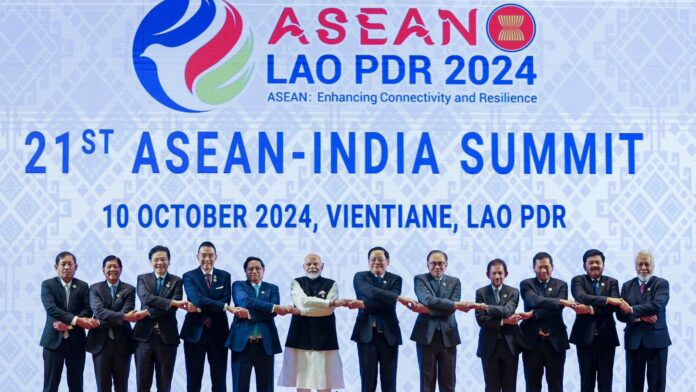India’s Act East Policy: Enhancing Connectivity and Partnerships in the Indo-Pacific
Continuing his outreach through the Act East Policy, Prime Minister Narendra Modi arrived in Laos for a two-day visit to participate in the ASEAN-India and East Asia summits. The primary goal was to fortify ties with member countries, focusing on areas such as connectivity and digital public infrastructure.
Upon landing in Vientiane, Modi participated in a blessing ceremony led by senior Buddhist monks. Sharing his experience on social media, he wrote, “I had the privilege of meeting esteemed monks and spiritual leaders in Laos, who expressed their joy at the recognition given to Pali by the Indian people. I am thankful for their blessings.”
During the summit, Prime Minister Modi emphasized the significant impact of India’s Act East Policy on its relations with ASEAN. “I had announced India’s Act-East policy. In the last decade, this policy has given new energy, direction, and momentum to the historic relations between India and ASEAN countries. Giving prominence to ASEAN, in 1991 we launched the Indo-Pacific Ocean Initiative.
This complements the ASEAN Outlook on the Indo-Pacific. Last year maritime exercises for regional security and stability were started. In the last 10 years, our trade with the ASEAN region has almost doubled to over 130 billion dollars. Today, India has direct flight connectivity with 7 ASEAN countries and soon direct flights will start with Brunei as well. We have opened new consulates in Timor Leste.
Singapore was the first country in the ASEAN region with which we established fintech connectivity and now this is being replicated in other countries as well,” Modi said.
The Act East Policy, introduced in November 2014, upgraded the earlier Look East Policy. This diplomatic initiative aims to strengthen economic, strategic, and cultural ties across the extensive Asia-Pacific region at multiple levels. It emphasizes ongoing and robust engagement with Southeast Asian nations in areas such as connectivity, trade, culture, defense, and interpersonal relationships, focusing on bilateral, regional, and multilateral frameworks.
The primary goal is to foster economic collaboration, cultural connections, and establish strategic partnerships with countries in the Indo-Pacific region through a proactive and practical approach. This policy also aims to boost the economic growth of the North Eastern Region (NER), which serves as a gateway to Southeast Asia.
Initially concentrated on the countries of the Association of Southeast Asian Nations (ASEAN) and economic integration, India became a dialogue partner with ASEAN in 1996 and attained summit-level partnership in 2002. By 2012, this relationship evolved into a Strategic Partnership. When the Look East Policy was launched in 1992, India’s trade with ASEAN was approximately USD 2 billion.
Following the Free Trade Agreement signed in 2010, trade surged to USD 72 billion by 2017-18. India is also actively involved in various regional forums, including the East Asia Summit (EAS) and the ASEAN Regional Forum (ARF).
The Act East Policy expands its focus beyond ASEAN countries and economic integration to include East Asian nations and security cooperation. The Indian Prime Minister identified four key components of the Act East Policy: Culture, Commerce, Connectivity, and Capacity building. A significant aspect of this policy is security, especially in light of increased Chinese assertiveness in the South China Sea and the Indian Ocean, where ensuring freedom of navigation and India’s strategic role are crucial. To advance these goals, India is actively participating in the Indo-Pacific framework and an informal group known as Quad.
Several initiatives have been launched to enhance connectivity under the Act East Policy:
1. The Agartala-Akhaura Rail Link connecting India and Bangladesh.
2. Intermodal transport connections and inland waterways through Bangladesh.
3. The Kaladan Multimodal Transit Transport Project and the Trilateral Highway Project linking the North East with Myanmar and Thailand.
4. Under the India-Japan Act East Forum, projects such as road and bridge construction and modernization of hydroelectric power facilities have been initiated.
India supported ASEAN nations with medicines and medical supplies during the pandemic. Additionally, 1,000 PhD scholarships have been made available at IITs for participants from ASEAN countries. India is also carrying out Quick Impact Projects in Cambodia, Laos, Myanmar, and Vietnam to assist grassroots communities in areas such as education, water resources, and healthcare. These Quick Impact Projects (QIPs) are designed to be small-scale and low-cost, with a focus on quick planning and implementation.
To increase the share of coastal shipping and inland water transport, 46 initiatives have been outlined in the Amrit Kaal Vision 2047. Major plans include establishing port-based agglomeration centers, creating coastal berths near production and demand hubs, and enhancing connectivity through road, rail, and inland waterways.
The initiative also seeks to operationalize 50 waterways by 2047 and introduce efficient low-draft vessel designs, potentially in combination with tug-barges to improve accessibility and effectiveness.
India’s Act East Policy has been instrumental in transforming its engagement with the ASEAN region and beyond. By fostering economic, cultural, and strategic ties, India aims to create a robust framework for regional cooperation and growth.
The policy’s emphasis on connectivity and practical collaboration highlights India’s commitment to playing a proactive role in the Indo-Pacific region. As PM Modi continues to advocate for these initiatives, the Act East Policy remains a cornerstone of India’s foreign policy strategy, driving forward its aspirations for regional integration and development.

